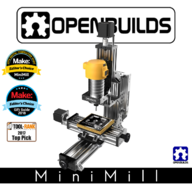OpenBuilds MiniMill
Discussion in 'CNC Mills/Routers' started by Mark Carew, May 26, 2017.
OpenBuilds MiniMill
Discussion in 'CNC Mills/Routers' started by Mark Carew, May 26, 2017.
This OpenBuilds Mini Mill is a great go-to desktop sized CNC milling plate / part maker and 3D carving machine!
Page 6 of 11
Page 6 of 11
